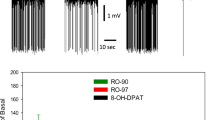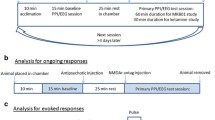Chronic experiments on rats were run to evaluate the effects of the substance α-NETA, a trace amine-associated receptor TAAR5 agonist, on the electrocorticogram (ECoG). Changes in the spectral power of the main ECoG rhythms were assessed, as was spatial synchronization in the γ range, because of the role of γ oscillations in the transmission of information between regions presumptively affected in schizophrenia. Adult male Wistar rats underwent implantation of six nichrome electrodes into the cerebral cortex of both hemispheres in two rows of three, with the aim of assessing the topography of the whole cortex. A total of 20 experiments were conducted: animals in 10 experiments received systemic doses of α-NETA, while in the other 10 animals received physiological saline. Injections of α-NETA increased power in the δ range (0–5 Hz) and there was a linked decrease in power in the range 5–10 Hz. The greatest differences were seen in the first 10 min. No changes occurred after administration of physiological saline. Increases in slow waves were accompanied by decreases in spatial synchronization of γ oscillations between all six recording points from the pre-injection baseline as compared with controls. All effects were more marked in the anterior zones of the cortex. The results suggest that α-NETA alters dopamine transmission via infl uences on TAAR5, which in turn disrupts glutamatergic transmission, leading to dysfunction in γ synchronization, as occurs in schizophrenia.
Similar content being viewed by others
References
I. E. Kanunikov, P. E. Lamkin, and D. R. Belov, “Indicators of EEG spatial synchronization in schoolchildren 10–12 years old in normal and with learning diffi culties,” Ros. Fiziol. Zh., 85, No. 3, 360–371 (1999).
M. N. Livanov, Spatial Synchronization of Brain Biopotentials, Nauka, Moscow (1973).
M. N. Livanov and N. E. Sviderskaya, “ Psychological aspects of the phenomenon of the spatial synchronization of potentials,” Psikhol. Zh., 5, No. 5, 71–83 (1984).
N. E. Sviderskaya, Synchronous Electrical Activity of the Brain and Mental Processes, Nauka, Moscow (1987).
A. N. Shepovalnikov, M. N. Tsitseroshin, L. G. Zaitseva, and E. I. Galperina, “Features of systemic interaction of different cortical areas of the left and right cerebral hemispheres in different sleep stages in humans,” Ros. Fiziol. Zh., 8, No. 10, 1228–1241 (2012).
A. Abi-Dargham, J. Rodenhiser, D. Printz, et al., “Increased baseline occupancy of D2-receptors by dopamine in schizophrenia,” Proc. Natl. Acad. Sci. USA, 97, No. 14, 8104–8109 (2000).
A. Abi-Dargham and O. Guillin, “Integrating the neurobiology of schizophrenia,” Int. Rev. Neurobiol., 78 (2007).
A. A. Aleksandrov, V. M. Knyazeva, A. B. Volnova, et al., “Identification of TAAR5 agonist activity of alpha-NETA and its effect on mismatch negativity amplitude in awake rats,” Neurotox. Res., 34, No. 3, 442–451 (2018), doi: https://doi.org/10.1007/s12640-018-9902-6.
A. A. Aleksandrov, E. S. Dmitrieva, A. B. Volnova, et al., “TAAR5 receptor agonist affects sensory gating in rats,” Neurosci. Lett., 666, No. 14, 144–147 (2018).
F. M. Benes, B. Lim, D. Matzilevich, et al., “Regulation of the GABA cell phenotype in hippocampus of schizophrenics and bipolars,” Proc. Natl. Acad. Sci. USA, 104, 10,164–10,169 (2007).
B. Borowsky, N. Adham, K. A. Jones, et al., “Trace amines: identification of a family of mammalian G protein-coupled receptors,” Proc. Natl. Acad. Sci. USA, 98, 8966–8971 (2001).
S. A. Burchett and T. P. Hicks, “The mysterious trace amines: Protean neuromodulators of synaptic transmission in mammalian brain,” Prog. Neurobiol., 79, No. 5–6, 223–246 (2006).
G. Buzsdki, “Neural syntax: Cell assemblies, synapsembles, and readers,” Neuron, 68, No. 3, 362–385 (2010).
G. Buzsáki and X.-J. Wang, “Mechanisms of gamma oscillations,” Annu. Rev. Neurosci., 35, 203–225 (2012).
J. A. Cardin, M. Carlten, K. Meletis, et al., “Driving fast-spiking cells induces gamma rhythm and controls sensory responses,” Nature, 459, No. 7247, 663–667 (2009).
R. R. Gainetdinov, A. R. Mohn, and M. G. Caron, “Genetic animal models: focus on schizophrenia,” Trends Neurosci., 24, No. 9, 527–533 (2001).
J. Gallinat, G. Winterer, C. S. Herrmann, and D. Senkowski, “Reduced oscillatory gamma-band responses in unmedicated schizophrenic patients indicate impaired frontal network processing,” Clin. Neurophysiol., 115, 1863–1874 (2004).
G. Gonzalez-Burgos and D. A. Lewis, “GABA neurons and the mechanisms of network oscillations: implications for understanding cortical dysfunction in schizophrenia,” Schizophr. Bull., 34, 944–961 (2008).
K. L. Graham, J. V. Zhang, S. Lewen, et al., “A novel CMKLR1 small molecule antagonist suppresses CNS autoimmune infl ammatory disease,” PLoS One, 9, No. 12, e112925 (2014).
O. Guillin, A. Abi-Dargham, and M. Laruelle, “Neurobiology of dopamine in schizophrenia,” Int. Rev. Neurobiol., 78, 1–39 (2007).
A. L. Halberstadt, “The phencyclidine-glutamate model of schizophrenia,” Clin. Neuropharmacol., 18, 237–249 (1995).
L. E. Hong, A. Summerfelt, R. McMahon, et al., “Evoked gamma band synchronization and the liability for schizophrenia,” Schizophr. Res., 70, 293–302 (2004).
O. Howes, R. McCutcheon, and J. Stone, “Glutamate and dopamine in schizophrenia: an update for the 21st century,” J. Psychopharmacol., 29, No. 2, 97–115 (2015).
A. V. Klimash, M. N. Tsitseroshin, A. N. Shepovalnikov, et al., “Disorders of the spatiotemporal organization of the brain’s bioelectrical activity in patients with different depressions of consciousness after severe head injury,” Human Physiol., 36, No. 5, 535–549 (2010).
B. Kocsis, “Differential role of NR2A and NR2B subunits in N-methyl-D-aspartate receptor antagonist-induced aberrant co rtical gamma oscillations,” Biol. Psychiatry, 71, 987–995 (2012).
B. Kolb, “Functions of the frontal cortex of the rat: a comparative review,” Brain Res., 320, No. 1, 65–98 (1984).
D. O. Kutsenko, A. A. Ivonin, V. T. Shuvaev, et al., “Spatial structure of EEG in depression patients with co-occurring anxiety disorders,” Human Physiol., 41, No. 1, 34–38 (2015).
J. S. Kwon, B. F. O’Donnell, G. V. Wallenstein, et al., “Gamma frequency- range abnormalities to auditory stimulation in schizophrenia,”,Arch. Gen. Psychiatry, 56, 1001–1005 (1999).
D. A. Lewis, T. Hashimoto, and D. W. Volk, “Cortical inhibitory neurons and schizophrenia,” Nat. Rev. Neurosci., 6, No. 4, 312–324 (2005).
D. A. Lewis, A. A. Curley, J. R. Glausier, and D. W. Volk, “Neuropsychiatric disorders cortical parvalbumin interneurons and cognitive dysfunction in schizophrenia,” Trends Neurosci., 35, No. 1, 57–67 (2012).
G. A. Light, J. L. Hsu, M. H. Hsieh, et al., “Gamma band oscillations reveal neural network cortical coherence dysfunction in schizophrenia patients,” Biol. Psychiatry, 60, 1231–1240 (2006).
L. Lindemann and M. C. Hoener, “A renaissance in trace amines inspired by a novel GPCR family,” TiPS, 25, 274–281 (2005).
D. J. Lodge and A. A. Grace, “Gestational methylazoxymethanol acetate administration: a developmental disruption model of schizophrenia,” Behav. Brain Res., 204, 306–312 (2009).
B. F. O’Donnel, W. P. Hetrick, J. L. Vohs, et al., “Neural synchronizationdeficits to auditory stimulation in bipolar disorder,” Neuroreport, 15, 1369–1372 (2004).
K. G. Phillips, M. C. Cotel, A. P. McCarthy, et al., “Differential effects of NMDA antagonists on high frequency and gamma EEG oscillations in a neurodevelopmental model of schizophrenia,” Neuropharmacology, 62, 1359–1370 (2012).
R. T. Premont, R. R. Gainetdinov, and M. G. Caron, “Following the trace of elusive amines,” Proc. Natl. Acad. Sci. USA, 98, No. 17, 9474–9475 (2001).
T. M. Preuss, “Do rats have prefrontal cortex? The rose-woolsey-akert program reconsidered,” J. Cogn. Neurosci., 7, No. 1, 1–24 (1995).
T. Sakurai, N. J. Gamo, T. Hikida, et al., “Converging models of schizophrenia-network alterations of prefrontal cortex underlying cognitive impairments,” Progr. Neurobiol., 134, 178–201 (2015).
Y.-W. Shin, B. F. O’Donnell, S. Youn, and J. S. Kwon, “Gamma oscillation in schizophrenia,” Psychiatry Investig., 8, 288–296 (2011).
A. A. Simen, R. DiLeone, and A. Arnsten, “Primate models of schizophrenia: future possibilities,” Genetic Models Schizophrenia, 179, 117–125 (2009).
V. S. Sohal, F. Zhang, O. Yizhar, and K. Deisseroth, “Parvalbumin neurons and gamma rhythms enhance cortical circuit performance,” Nature, 459, 698–702 (2009).
R. D. Traub, “Fast oscillations,” Scholarpedia, 1, No. 12, 1764 (2006).
P. J. Uhlhaas and W. Singer, “Neural synchrony in brain disorders: relevance for cognitive dysfunctions and pathophysiology,” Neuron, 52, No. 1, 155–168 (2006).
P. J. Uhlhaas and W. Singer, “Abnormal neural oscillations and synchrony in schizophrenia,” Nature Rev. Neurosci., 11, No. 2, 100–113 (2010).
H. B. Uylings, H. J. Groenewegen, and B. Kolb, “Do rats have a prefrontal cortex?” Behav. Brain Res., 146, No. 1–2, 3–17 (2003).
C. Von der Malsburg, “Binding in models of perception and brain function,” Curr. Opin. Neurobiol., 5, 520–526 (1995).
D. R. Weinberger and P. J. Harrison, “Dopamine and schizophrenia,” in: Schizophrenia, A. Abi-Dargham and A. Grace (eds.), Wiley Online Library (2011).
S. Williams and P. Boksa, “Gamma oscillations and schizophrenia,” J. Psychiatry Neurosci., 35, No. 2, 75–77 (2010).
Author information
Authors and Affiliations
Corresponding author
Additional information
Translated from Rossiiskii Fiziologicheskii Zhurnal imeni I. M. Sechenova, Vol. 104, No. 11, pp. 1275–1290, November, 2018.
Rights and permissions
About this article
Cite this article
Belov, D.R., Fesenko, Z.S., Lakstygal, A.M. et al. Effects of a Trace Amine-Associated Receptor TAAR5 Agonist as a Model of Schizophrenia Using Electrocorticography Data from Rats. Neurosci Behav Physi 50, 335–344 (2020). https://doi.org/10.1007/s11055-020-00905-2
Received:
Revised:
Accepted:
Published:
Issue Date:
DOI: https://doi.org/10.1007/s11055-020-00905-2




